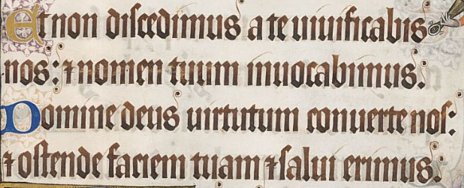Script Type : minuscule
Alternative Name : textura prescissa sine pedibus, referring to the lack of feet at the bases of letters
Date : 12th to 15th centuries
Location : Spread from France and the Low Countries across western Europe. This example is from England.
Function : Book hand of very formal grade


























Distinctive letters : This script is easy to read because the letters, although angular, are large, clear, well formed and well separated. This is perhaps the most painstakingly written of the Gothic scripts, with the distinguishing characteristic that the bottoms of the vertical strokes of many letters are finished off neat and square, without any kind of feet. This is hard work for the scribe. The highly decorative nature of the script is evidenced by the elaborate curls that appear on g, h, y and the low form of s. The letter i has a fine diagonal slash above it.
As with most formal Gothic scripts, there are two forms of r, one of which is the truncated form that appears after some vowels. There are also two forms of s, the tall and the short and curly types. The letters u and v are identical, as are i and j. There are no examples here of k, w or z.
The only abbreviation is a form of Tironian et.
Pass the cursor slowly down the lines of text for a transcript. To look at the page in more detail, proceed to the paleography exercises.
Paleography
exercises using Flash ![]()
Requires at least the Flash 5 plugin
If you are looking at this page without frames, there is more information about medieval writing to be found by going to the home page (framed) or the site map (no frames).